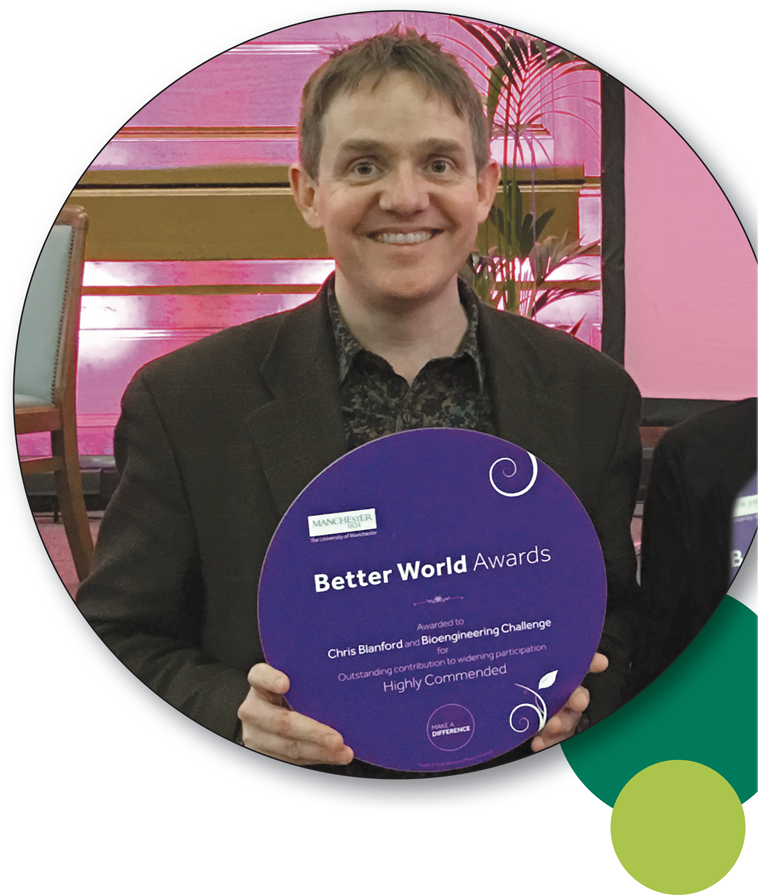Christopher Blanford, currently a senior lecturer in biomaterials at The University of Manchester in the UK, wandered into the field of materials science almost by the will of the universe. When he was selecting his major for undergraduate studies at the University of Notre Dame, he was not aware of materials science as a discipline. Chemical engineering appealed to him because of its practicality and the promise of good placement after graduation. He completed his PhD degree in inorganic chemistry at the University of Minnesota Twin Cities. “It was there that I was exposed to materials science by my supervisors in chemistry and materials science, Andreas Stein and C. Barry Carter,” he explained.

Chris now leads a team of researchers based at the Manchester Institute of Biotechnology (MIB) with collaborators from across the globe. In a joint effort with Matthieu Gresil, Monash University, and Kirk Malone, MIB, they were able to use enzymes to promote self-healing properties in polymers. He is also excited about their recent findings related to a Bill & Melinda Gates Foundation project led by Bruce Grieve at The University of Manchester. “We use textured materials as the biological recognition element for fungal pathogens that affect wheat in East Africa. We expect to see these inexpensive ‘Sentinels’ deployed on farms in Ethiopia over the next two or three years,” he explained. In addition, he is working with Nicolas Mano, at the Centre National de la Recherche Scientifique in Bordeaux, and Lu Shin Wong, at The University of Manchester, on multicopper oxidases, which are robust biological catalysts for low-temperature fuel cells. But Chris's research does not stop there.
“I have also had a productive collaboration with Gyorgy Szekely at KAUST [King Abdullah University of Science and Technology] on making materials for organic solvent nanofiltration. In light of the recent COVID-19 crisis, I see multifunctional filtration as an emerging area. Imagine having a mask or gown made of fibers that not only remove infectious materials, but also neutralize them and alert the user to their presence, say, by a color change. Functional fibers like these can already be produced at pilot scale,” he said.
Projects that have materials at their heart are a way to identify and track environmental pathogens before they infect us, our animals, or our food supply. “More generally, I hope that the public now better appreciates the time scales for development, the need for wider collaboration and financial investment before a challenge arises,” he added.
However, students first need to be made aware of materials science as a discipline, especially in the United States. “In my opinion, it is the best degree that no one knows about! I've gone into schools or given presentations to prospective students to show the breadth and potential of the field. Students have said that they couldn't decide between the practical elements of engineering and the fundamentals of chemistry or physics, and now they've found what they want to study,” he explained. Chris actively works to raise awareness of the field. He is most proud of a team effort to mass produce “chocolate biscuit impact testers,” based on a design from The University of Sheffield. “We worked with Manchester undergraduates, the [Worshipful Company of] Armourers & Brasiers, and Manchester's Museum of Science and Industry to create dozens of kits for local schools,” he said.

“On the academic side, I love the efficiency of American research, and I love the room for creative thought that I have in the UK,” he explained. The MIB's creative, collegial environment has allowed him to benefit from the interactions that the Institute's structure and philosophies foster. On top of that, the massive scale of the university, albeit daunting, means that there is always an expert or an instrument within a 15-minute walk.
Chris has been involved with the Materials Research Society (MRS) since his doctoral studies at the University of Minnesota. It is still his favorite society meeting where he can get new ideas from outside his area of research.
He was a 2013 MRS Spring Meeting symposium organizer, and currently serves as the MRS Postdoctoral Awards Subcommittee chair. “For the postdoctoral awards, I look for the potential of the candidates to positively influence society throughout their career. I work to look beyond publication metrics to consider the candidate's journey given their personal circumstances. Materials science features in all aspects of our lives, so the subcommittee members and I always make sure to consider all aspects of a candidate's promise, including advocacy and mentoring,” he explained.
The societal benefit of research is a topic that is very close to Chris's heart, and he hopes that in the next 30 years, his research can make a meaningful impact on society. He stressed the importance of conveying to the public how materials science improves our lives and our future, especially from a sustainability standpoint. Because of the systematic nature of research, important progress in this field seldom makes it to sensational headlines to be consumed by the public. As a result, he emphasizes, it is our duty as experts in this domain to communicate and collaborate with social scientists to get the message across.



